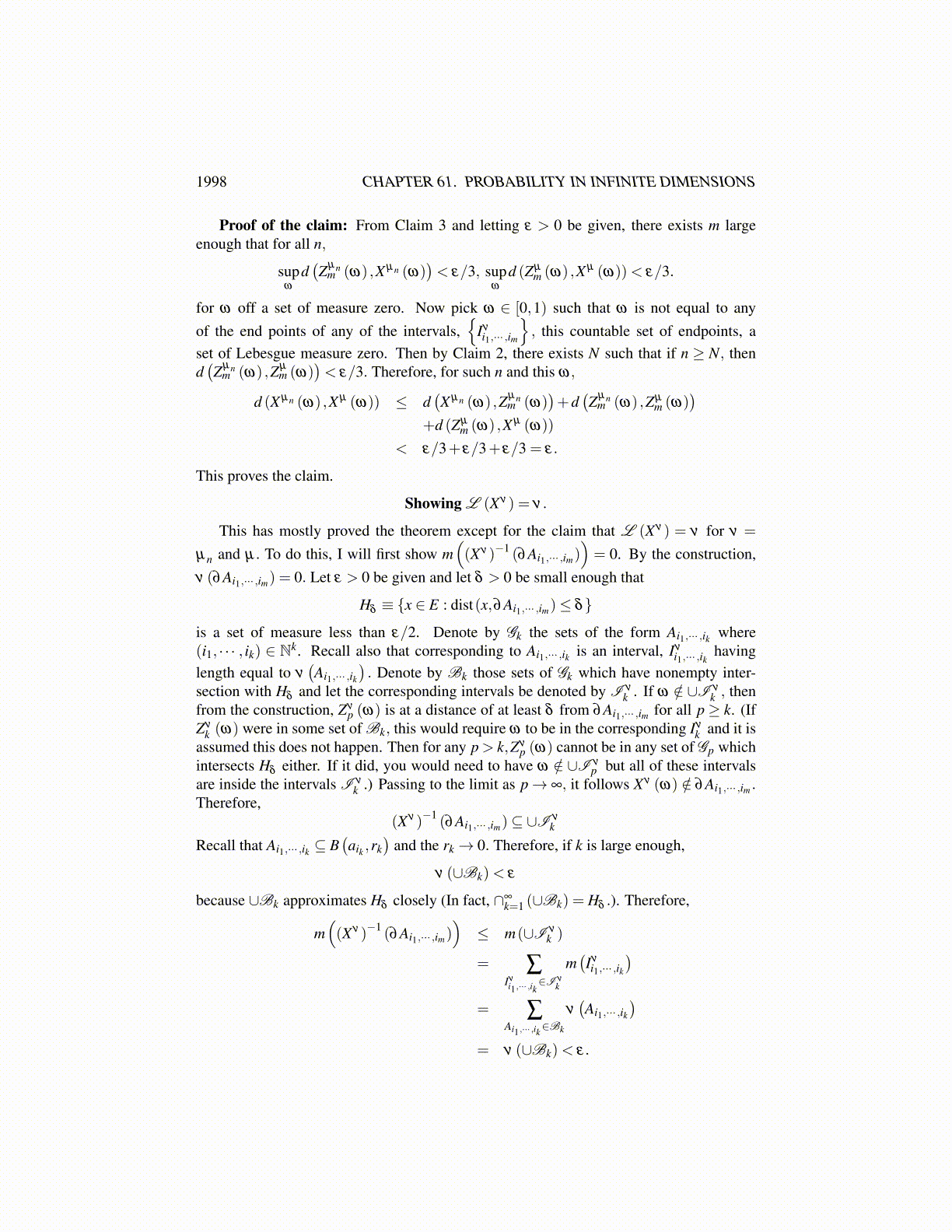
1998 CHAPTER 61. PROBABILITY IN INFINITE DIMENSIONS
Thus m(
Iνi1··· ,im, j
)= ν (Ai1··· ,im, j) and
ν (Ai1··· ,im) =∞
∑k=1
ν(Ai1··· ,im,k
)=
∞
∑k=1
m(Iνi1··· ,im,k
)= β −α,
the intervals, Iνi1··· ,im, j being disjoint and
Iν
i1 ··· ,im= ∪∞
j=1Iνi1··· ,im, j.
These intervals satisfy the same inclusion properties as the sets {Ai1,··· ,im} . They are juston [0,1) rather than on E. The intervals Iν
i1 ··· ,imkcorrespond to the sets Ai1··· ,im,k and in fact
the Lebesgue measure of the interval is the same as ν(Ai1··· ,im,k
).
Choosing the sequence {rk} in an auspicious manner
There are at most countably many positive numbers, r such that for ν = µn or µ ,
ν (∂B(ai,r))> 0
This is because ν is a finite measure. Taking the countable union of these countable sets,there are only countably many r such that ν (∂B(ai,r))> 0 for some ai. Let the sequenceavoid all these bad values of r. Thus for
F ≡ ∪∞m=1∪∞
k=1 ∂B(ak,rm)
and ν = µ or µn,ν (F) = 0. Here the rm are all good values such that for all k,m, ∂B(ak,rm)has µ measure zero and µn measure zero.
Claim 1: ∂Ai1,··· ,ik ⊆ F. This really follows from the construction. However, the detailsfollow.
Proof of claim: Suppose C is a Borel set for which ∂C ⊆ F. I need to show ∂Crik ∈ F.
First consider k = 1. Then Cri1 ≡ B(a1,ri)∩C. If x ∈ ∂Cri
1 , then B(x,δ ) contains pointsof B(a1,ri)∩C and points of B(a1,ri)
C ∪CC for every δ > 0. First suppose x ∈ B(a1,ri) .
Then a small enough neighborhood of x has no points of B(a1,ri)C and so every B(x,δ )
has points of C and points of CC so that x ∈ ∂C ⊆ F by assumption. If x ∈ ∂Cri1 , then it
can’t happen that ||x−a1|| > ri because then there would be a neighborhood of x havingno points of Cri
1 . The only other case to consider is that ||x−ai|| = ri but this says x ∈ F.Now assume ∂Cri
j ⊆ F for j ≤ k−1 and consider ∂Crik .
Crik ≡ B(ak,ri)∩C \∪k−1
j=1Crij
= B(ak,ri)∩C∩(∩k−1
j=1
(Cri
j
)C)
(61.4.10)
Consider x ∈ ∂Crik . If x ∈ int(B(ak,ri)∩C)(int≡ interior) then a small enough ball about
x contains no points of (B(ak,ri)∩C)C and so every ball about x must contain points of(∩k−1
j=1
(Cri
j
)C)C
= ∪k−1j=1Cri
j